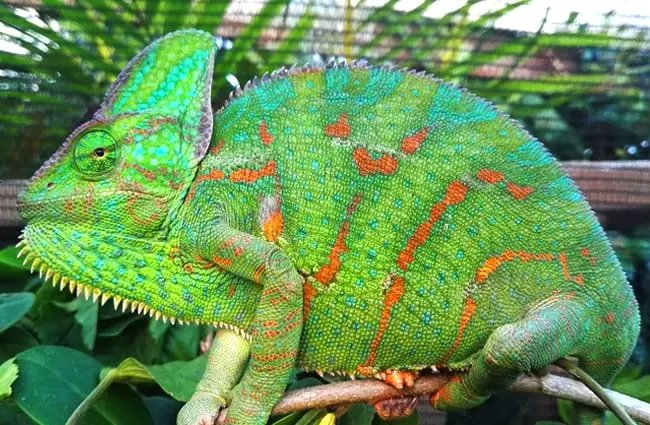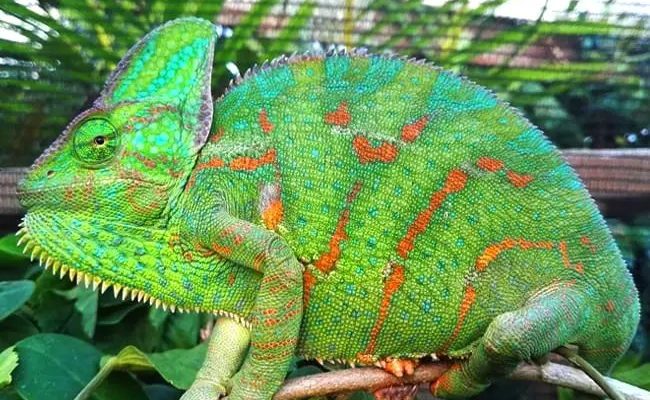
Choosing a pet is a lot like picking a new hobby—it should match your lifestyle and interests. The veiled chameleon is not just visually stunning with its vibrant colors; it also brings a unique challenge and joy to pet ownership. Of course, it’s essential to understand what it takes to care for one before jumping in. So, let’s explore whether a veiled chameleon could be the perfect pet for you, especially if you’re just starting out on your pet parent journey.
Understanding the Veiled Chameleon
The veiled chameleon, known scientifically as *Chamaeleo calyptratus*, is a species native to the Arabian Peninsula. These chameleons are famous for their ability to change colors based on their mood, temperature, and even their environment. Imagine how fun it would be to watch your pet transform before your eyes! From vibrant greens to striking blues, their color-changing ability is not just for show; it helps them regulate their body temperature and communicate with other chameleons.
In terms of size, veiled chameleons can grow quite large, reaching lengths of about 15 to 24 inches. This size can be a consideration when setting up their habitat. They need plenty of space to climb, explore, and bask under a heat source—after all, they’re used to living in the trees of their desert habitats. Just picture them lounging on a branch, soaking up the sun—it’s a sight to behold!
Another interesting fact is that these chameleons have unique personalities. Unlike some pets that might bond closely with their owners, veiled chameleons often prefer their own space. They might not cuddle or play fetch, but they each have their quirks and can be quite entertaining to observe.
Does the Veiled Chameleon Make a Good Pet for Beginners?
You might be wondering if a veiled chameleon is the right fit for your home. Honestly, the answer depends on your interest and commitment level. These lizards can be a good option for beginners, but with a few important caveats. Unlike a dog or cat that might thrive on constant interaction, chameleons are more independent creatures. If you’re looking for a pet that requires minimal handling and is low-maintenance, a veiled chameleon could be appealing.
However, it’s essential to note that they do require specific care, including a controlled environment, proper lighting, and a balanced diet of live insects. If you’re not up for a bit of research and setup, it’s worth considering other pet options. Imagine setting up a mini jungle in your home; if that excites you, then you’re on the right track!
Setting Up the Perfect Habitat
Creating a suitable habitat is crucial for your veiled chameleon’s well-being. These reptiles thrive in a well-ventilated enclosure that mimics their natural environment. A screen terrarium is often recommended because it allows for proper airflow and humidity levels. You’ll want to choose a tank that’s at least 2 feet tall to give them enough vertical space to climb.
Inside the enclosure, you’ll need to provide various climbing branches, plenty of foliage, and a basking spot where they can soak up heat. Think of it like building a jungle gym for your chameleon! Here are some essentials for their habitat:
- Branches and vines: These provide climbing space and help them feel secure.
- Live plants: Not only do they look nice, but they also help maintain humidity.
- Heat lamp: Chameleons need a basking area to regulate their body temperature.
- Water source: A dripper system mimics rain, which is vital for hydration.
Make sure to monitor the temperature and humidity levels regularly. A digital thermometer and hygrometer can help you keep track of these conditions.
Feeding Your Veiled Chameleon
Feeding a veiled chameleon is one of the more enjoyable aspects of ownership, but it comes with responsibility. They are insectivores, which means they primarily eat live insects. Crickets, mealworms, and roaches are all popular options. You might be wondering how often to feed them—generally, young chameleons require daily feedings, while adults can eat every other day.
You’ll also need to dust their food with calcium and vitamin supplements. This is crucial for preventing health issues related to nutrient deficiencies. Think of it like making sure your furry friend gets their daily vitamins; it’s just as important for your chameleon.
While feeding, you’ll want to provide a varied diet to keep them healthy—like mixing things up with different types of insects. It’s part of their charm! Watching them hunt and catch their food can be a delightful experience. Just make sure not to overfeed, as obesity can lead to other health problems.
Handling and Behavior
Handling a veiled chameleon can be tricky. They are not known for their social nature, and while some can tolerate gentle handling, others may become stressed. Here’s the thing: if you’re looking for a pet to cuddle up with on the couch, this might not be the right choice. They tend to prefer observing their surroundings from a distance rather than being held.
If you do decide to handle your chameleon, do so with care. Start by letting them become familiar with your presence before attempting to pick them up. When you do, approach slowly and gently, using both hands to support their body. This will help make the experience less stressful.
Be mindful of their body language as well. If your chameleon turns dark or puffs up, it may be feeling threatened. Always prioritize their comfort and respect their space. Over time, you might find that your chameleon becomes more comfortable with you, but patience is key.
Common Health Issues to Watch For
Just like any pet, veiled chameleons can face health issues. As a beginner, knowing what to look for can save you a lot of worry down the line. Some common health problems include:
- Dehydration: Often, chameleons won’t drink from standing water, so they may become dehydrated if hydration isn’t provided properly.
- Metabolic bone disease: This can occur if they don’t get enough UVB light or calcium. It’s vital to ensure proper lighting in their habitat.
- Respiratory infections: These can happen if the humidity is too high or if the enclosure is not well-ventilated.
Regular check-ups with a reptile veterinarian can help identify issues early, so don’t hesitate to seek professional advice if you notice anything concerning. First-time pet owners often feel overwhelmed, but a little preventive care goes a long way.
So, is the veiled chameleon a good pet for beginners? The answer largely depends on your willingness to learn and your ability to create a comfortable environment for them. They can make fascinating companions for those who appreciate their unique beauty and independence. As you dive into this adventure, remember that every pet requires attention, care, and sometimes, a bit of troubleshooting.
If you’re ready to create a mini rainforest in your living room and enjoy watching a creature that embodies both charm and mystery, the veiled chameleon could be your perfect match. Whether you’re observing their color changes or marveling at their hunting skills, they’re bound to bring a little magic into your life. Happy chameleon-keeping!

